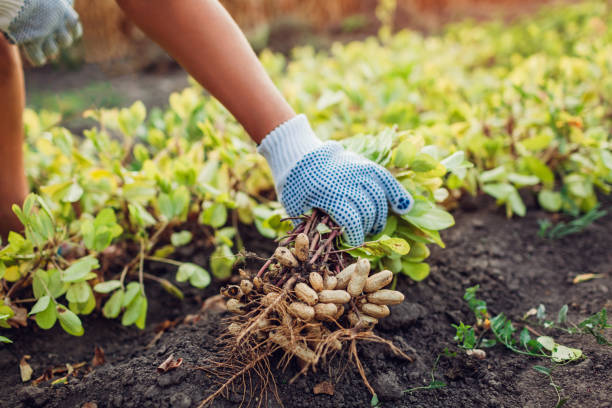Step By Step Guidelines for Peanut Cultivation in India


Peanuts are one of the top oil seed crops grown in Asian countries. You can widely grow peanuts in tropical and subtropical regions, which is important for small and large commercial growers. Peanut is an annual herbaceous plant that can grow up to 50 cm in height. Peanuts belong to the “Fabaceae” and the genus of the “Arachis” family. India is the second-largest producer of peanuts in Asia after China. We can use the peanuts in cooking by roasting, making peanut flour and extracting peanut oil. Peanuts are rich in essential nutrients.
One hundred grams of peanuts contain 550 calories and are an excellent source of several B vitamins, vitamin E, several dietary minerals, such as manganese, magnesium and phosphorus, and dietary fibre. Peanut seeds contain about 40 to 45% oil and 25% protein. The peanut kernel is very easily digestible, and the oil cake obtained after the extraction of peanut is a valuable organic manure and animal feed. It contains 1% phosphorus and 1% potash. Peanut is a good crop that builds soil fertility by fixing atmospheric nitrogen through root nodules. Peanut cultivation is also an excellent cover crop, especially for lands expose to soil erosion. Commercial cultivation of peanuts is quite successful, and one can easily earn good profits provided certain field management practises are practised.
Process of Peanut Farming in India
When you start a peanut plant to sow, you need to know the many most prominent sections that would be helpful in profitable cultivation. You must also know which are more trustworthy tractors in peanut cultivation. You can use the Swaraj tractor and any other that is helpful in the complete procedure of farming. Apart from this, Trakstar tractor is very affordable for Indian farmers.
Suitable Soil for Peanut Farming
Farmers grow peanuts in sandy loam soil with good drainage. Well-drained and deep soils with a pH of 6.5-7.0 and high fertility are ideal for peanuts. The ideal soil temperature for the good germination of peanuts is 30°C. And also low sowing temperatures delay germination and increase seed and seedling diseases. Before starting the cultivation of peanuts, the soil must be tested.
Crop rotation in peanut cultivation :-
Crop rotation is very important. It helps efficiently utilise nutrients and reduces soil-borne diseases and nematodes. Crop rotation also helps in reducing the incidence of weeds and also peanuts can be followed by maize, Jowar, Bajra or small cereal crops. It is recommended not to grow peanuts after peanuts, tobacco, or cotton to reduce the incidence of soil-borne diseases.
Sowing Preparation in Peanut Farming
Plot design: When testing for yield and quantitative characters, treatments are to be randomised and arranged in the plots in blocks. The plot size is four rows of 4m length, with 30 cm between rows and 10 cm between plants.

Seed and Layout Preparation in Peanut Farming
1. Preparatory Step:-
Experimental area maps showing the randomization of treatments, blocks, row direction, number of rows, row width, row length and street width is generating. Next, seed and fertiliser packets are prepared for each row.
2. Seed Selection:-
Bold and well-loaded pods are selecting for shelling about a week before sowing. The viability of the kernels can deteriorate after prolonged peeling and storage and are subject to storage insect damage. Plants produced from thicker kernels are correspondingly better than smaller kernels in their rate of emergence, number of successful shoots, number of primary branches and leaves, and dry mass of roots, twigs, total dry matter and pod yield.
3. Seed Treatment:-
To control seed and seedling disease-causing pathogens, seed before sowing should be treated with Thiram® (AI 5 0% @ 3 g kg-1 seed) or Bavistin® (AI 5 0% @ 2). It is necessary to cover with gram kg’ 1 seed). You can inoculate the seed during sowing to ensure good nodulation where rhizobia have been found in soil.
4. Seed Germination Rate:-
For bunch varieties, the recommended population is 330000 plant hectare-1 (about one plant per (10 x 30 cm). In the case of spreading varieties and also semi spreading, the recommended population is 250 000 plants hectare-1 (one plant per 40 x 10 cm).
Sowing in Peanut Farming
- Sowing of peanuts during the rainy season begins with the onset of rains, usually by the third week of June.
- Check the soil before sowing for optimum moisture content after rain or irrigate before sowing to ensure good germination.
- You should keep the seed 5 to 6 cm apart during the sowing. Put it in the soil at a depth of compact soil around the seed. To ensure firm contact with soil moisture for rapid and uniform germination. A seed drill with a packing wheel is useful to ensure uniform germination.
- When sowing manually, ensure that the same person completes plots in each block to reduce variation due to unequal sowing due to human differences.
Need the Equipment in the Peanut Cultivation
When you want to get information about farming, you should also know the tools that will help in increasing the yield. Rotavator, Cultivator, Tiller and Tractor are essential in every type of farming. However, among all the equipment, the tractor is the most important. That’s why we recommend the Indo Farm Tractor for peanut cultivation in India.
For more information regarding peanut farming in India, stay tuned with us.
Cultivation: Blogrind.com





